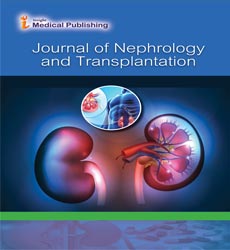Effect of COVID-19 on Kidney patients
Johnny Saremirad*
Department of Nephrology, Stanford University, Sousse, Tunisia, Jamaica
- *Corresponding Author:
- Johnny Saremirad
Department of Nephrology, Stanford University, Sousse, Tunisia,
Jamaica;
E-mail: JohnnySaremirad@gmail.com
Received: February 18, 2022, Manuscript No. IPNT-22-11483; Editor assigned: February 21, 2022, PreQC No. IPNT-22-11483 (PQ); Reviewed: March 07, 2022, QC No. IPNT-22-11483; Revised: March 11, 2022, Manuscript No. IPNT-22-11483 (R); Published: March 18, 2022, Invoice No. IPNT-22-11483
Citation: Saremirad J (2022) Effect of COVID-19 on Kidney Patients. J Nephrol Transplant Vol:6 No:1
Editorial
A very Severe Respiratory Disease, COVID-19 (SARSCoV2), caused a pollution known as COVID Disease 2019 (COVID-19), which spread rapidly and caused a pandemic. Weakened to an abnormal level. Fortunately, the majority of COVID-19 positive patients have mild indications, but experienced individuals and patients with comorbidities require regular treatment in a serious clinic. It can cause airway obstruction. The effect of COVID-19 on local areas of the kidney was significant at several levels: dialysis patients with end-stage renal infection and patients with renal metastasis are at risk of COVID-19 entanglement and have a high mortality rate; severe renal damage caused by it is a constant difficulty in severe cases and is also associated with high mortality. There is also a glomerular contribution associated with COVID-19, which in many cases can be manifested by implosive glomerular disease and columnar damage.
This overall renal pathology associated with COVID-19 contributes significantly to the global weight of kidney disease in terms of human distress and the cost of the clinical framework. It is estimated that more than millions of people on the planet are experiencing the negative effects of kidney disease. This makes kidney disease one of the most common infectious diseases in the world. Non-emergency inpatients treated by a nephrologist are also more daunting, with the most pronounced grief and mortality. Taken as a whole, the effects of COVID-19 on the renal environment and patients can be devastating. Progressive persistent renal disease (CKD) has been identified in a particular order as a major risk factor for death in COVID-19 patients, or dialysis patients.
The nephrology community around the world has successfully addressed the challenges of COVID-19. The effects of COVID-19 infection do more than just affect patients who have had a previous kidney disease or kidney transplant. Kidney disease usually occurs in inpatients with COVID-19, especially those with extreme medical conditions who require gradual treatment. The AKI rate for these patients is very high and is associated with high mortality. The pathophysiology of this type of AKI has not been identified, but several factors are involved, including the initiation of congenital immortal scaffolding, dietary supplement activation, angiotensin over activity, and improved hypercoagulability. I am. Anyway, AKI is mainly due to hypotension and sepsis in many patients. Another recurring factor in patients with COVID-19 is implosive glomerulopathy, which is primarily associated with AKI and in African Americans with the APOL hazard allele.
Despite the strong clinical considerations that the nephrology community needs to deal with these debilitated patients with COVID-19; work has also been done to pass on new data collected rapidly over the past year. The importance of proteinuria includes the assessment and technique for its discovery, the component in question, and the importance of "new" proteinuria in patients with COVID-19. Angiotensin Converting Enzyme 2 (ACE2) is the major receptor for viral cell passage of SARSCoV2. In the kidney, ACE2 is mainly available at the apical border of proximal tubular cells and is less important in podocytes. Whether SARSCoV2 attack on the kidney causes some of the COVID-19 signs outlined above remains the subject of some debate. There are many studies that fully archive the presence of SARSCoV2 in glomerular and proximal tubular cells.
Similar to SARSCoV, some drugs, such as renin-an-framework (RAS) blockers, may be harmful to COVID-19 patients after ACE2 was confirmed to be a SARSCoV2 receptor in January 2020. Concerns have been raised that there is. Concerns have relied on previous studies of COVID-19, most of which are related to laboratory animals, indicating that ACE2 may be unregulated in the heart, renal vessels, and various organs. However, subsequent studies have shown that the lungs, where the SARSCoV2 section is located, do not have dilated ACE2 articulations. Following the underlying concerns, some distribution and location clarifications by the logical strength of social order do not have to abandon these prescriptions while waiting for research to solve this problem clinically. Comforted the area. All concerns have been raised, and a year after many distributions have resolved this issue, it seems very clear that the use of RAS blockers is generally protected in relation to COVID-19.
Open Access Journals
- Aquaculture & Veterinary Science
- Chemistry & Chemical Sciences
- Clinical Sciences
- Engineering
- General Science
- Genetics & Molecular Biology
- Health Care & Nursing
- Immunology & Microbiology
- Materials Science
- Mathematics & Physics
- Medical Sciences
- Neurology & Psychiatry
- Oncology & Cancer Science
- Pharmaceutical Sciences
